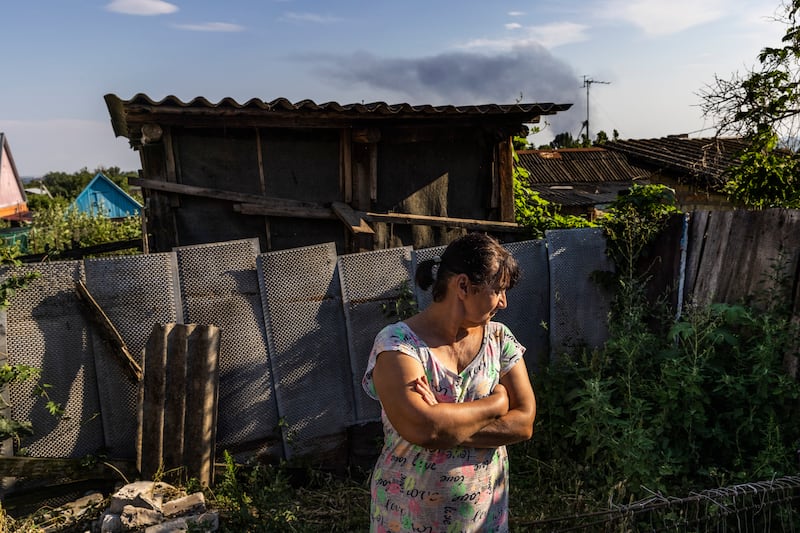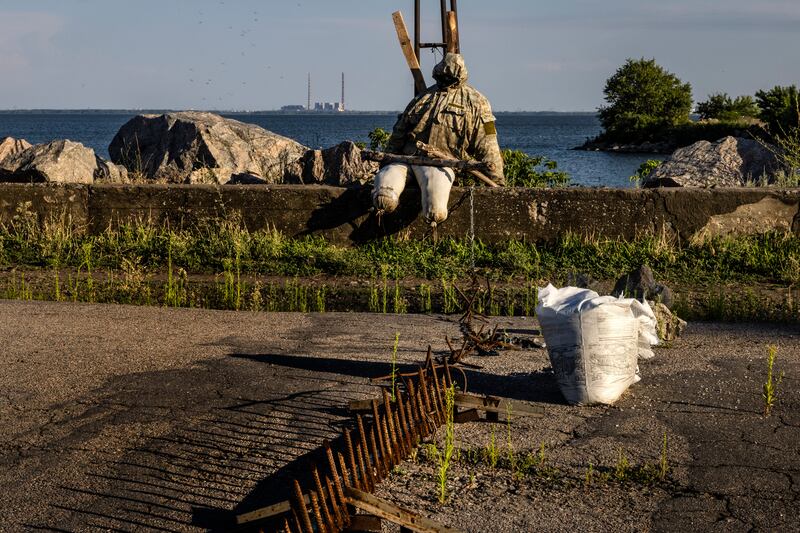Along most of the front line in Russia’s war in Ukraine, when one side lets loose with an artillery attack, the other shoots back.
But not in Nikopol, a city deep in southern farm country where the Ukrainian military faces a new and vexing obstacle as it prepares for a major counteroffensive: a nuclear power station that the Russian army has turned into a fortress.
Nikopol, controlled by the Ukrainians, lies on the west bank of the Dnieper River. On the opposite bank sits a gigantic nuclear power plant — Europe’s largest — that the Russian army captured in March. The Russians have been firing from the cover of the Zaporizhzhia power station since mid-July, Ukrainian military and civilian officials said, sending rockets over the river at Nikopol and other targets.
It is, in effect, a free shot. Ukraine cannot unleash volleys of shells in return using American-provided advanced rocket systems, which have silenced Russian guns elsewhere on the front line. Doing so would risk striking one of the six pressurised water reactors or highly radioactive waste in storage. And Russia knows it.
Dizzying turnaround in US-Ukraine relations leaves all eyes on Russia
US says ‘ball in Russia’s court’ after Ukraine agrees to 30-day ceasefire
Russia warns against ‘rose-tinted glasses’ over Trump after biggest Ukrainian drone strike of war
As NordStream operator fights legal action in Europe, speculation of US-Russian pipeline partnership grows

“They are hiding there so they cannot be hit,” said Nikopol Mayor Oleksandr Sayuk. “Why else would they be at the electrical station? To use such an object as a shield is very dangerous.”
Residents have been fleeing Nikopol because of the dangers of both shelling and of a potential radiation leak. And those who remain feel helpless, as if they are targets in a shooting gallery.
“We are like condemned prisoners who must just stand still and be shot at,” said Halyna Hrashchenkova, a retiree whose home was hit by Russian artillery. “They shoot at us, and there is nothing we can do.”
The attacks from the nuclear plant are complicating Ukraine’s plans in the south, which has become the focal point of the war as Russian advances in the east have slowed.
[ ‘Ireland has discovered Ukraine because of war’Opens in new window ]
For more than two months, the Ukrainian army has been telegraphing an intention to counterattack on the west bank of the Dnieper River, with the goal being to liberate the city of Kherson. Using a long-range American rocket-launching system known as Himars, Ukraine has been softening up Russian positions and cutting supply lines. Rocket strikes in July destroyed a road and railroad bridges pivotal for Russian resupply of forces on the west bank, to the south of Nikopol, closer to Kherson.
As the counterattack picks up, the Zaporizhzhia nuclear plant poses a quandary. Russian forces have occupied the nuclear site since March 4th but began using it for artillery strikes only three weeks ago, Ukrainian officials say, about when Himars appeared on the battlefield. Shielded from return fire, the Russians are menacing Ukrainian troops advancing toward the Nova Kakhovka dam on the Dnieper River, one of the last remaining crossing points for Russian resupply.

It is a problem Ukraine will have to solve as it moves troops and equipment into the area for the counteroffensive.
The Ukrainian army’s retaliatory options at Nikopol are limited. One tactic it has tried is to execute precision strikes that avoid, as much as possible, the risk of damaging the reactors. On July 22nd, for instance, Ukraine’s military intelligence agency reported a strike with a kamikaze drone that blew up an anti-aircraft installation and a Grad rocket launcher and that killed soldiers in a tent camp about 150 yards from a reactor.
The fighting near the power plant has renewed worries that the war will set off a release of radiation in a country chockablock with delicate and dangerous nuclear sites, including Chernobyl, which Russia occupied in March but then abandoned. Last Friday, a huge, roiling plume of black smoke rose a few miles south of the reactors, and the Ukrainian military said it had hit a Russian ammunition depot.
When the Russian army seized the Zaporizhzhia plant in March, combat ignited a fire — and a good deal of worry about nuclear safety. In that fighting, shrapnel hit but did not breach the containment structure of Reactor No 1. Three of the six reactors are active now, and the others are idled or under repair.
Only a direct strike with a powerful weapon would penetrate the reactors’ yard-thick concrete containment vessels, said Dmytro Orlov, exiled mayor of the city of Enerhodar, where the reactor is, and a former engineer at the plant. But if that happened, it would risk a meltdown or explosion that could spread radiation on the wind within Ukraine and beyond, as happened at Chernobyl in 1986, the world’s worst nuclear disaster.
Another risk is that a shell could hit the highly radioactive spent fuel stored in concrete canisters and spread radiation locally in the open air, like a dirty bomb.

The fatigue and stress of the Ukrainian control room employees at the reactors are also a concern. Russian soldiers have subjected them to harsh interrogations, including torture with electrical shocks, suspecting them of sabotage or of informing the Ukrainian military about activities at the plant, Orlov said. About a dozen have vanished after being abducted, he said.
The site is in a nuclear regulatory limbo. The Russian military controls the plant, but Ukrainian engineers operate it. The Russians allow Ukrainian truck convoys across the front line with spare parts and chemicals needed to process cooling water. Ukrainian nuclear regulators also cross the front to visit the plant. Rosatom, the Russian state nuclear company, has sent about a dozen engineers to monitor its operation.
The nuclear plant presents a unique challenge that Ukraine has not had to deal with previously in the war.
Colonel Serhiy Shatalov, who has been leading a Ukrainian infantry battalion on a creeping, village-by-village advance toward the Nova Kakhovka dam, said Russian artillery had mostly gone quiet after a few weeks of Himars strikes — except from the Russian units at the nuclear power plant.
“How can we respond?” he said. “This is a nuclear site.”
Of the Russians’ use of the reactors for cover, he said, “don’t search for fairness in war, especially if you fight the Russians.” — This article originally appeared in The New York Times














